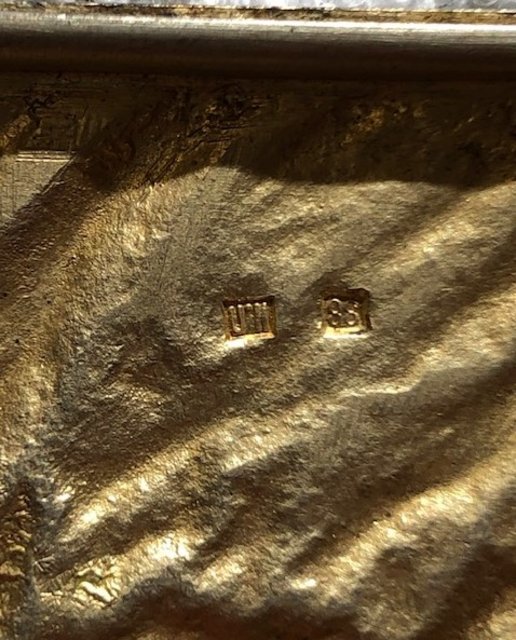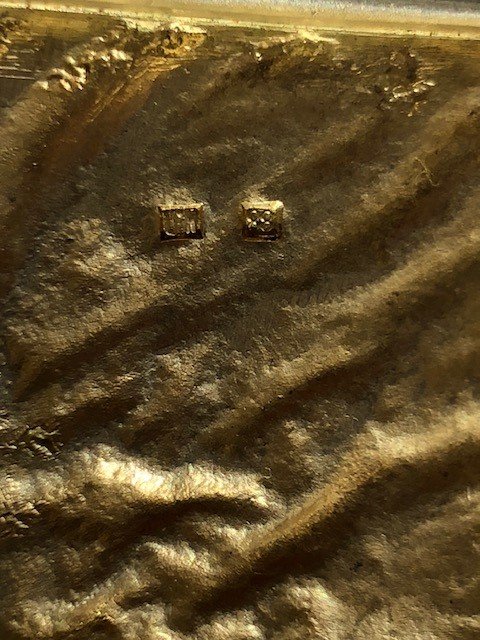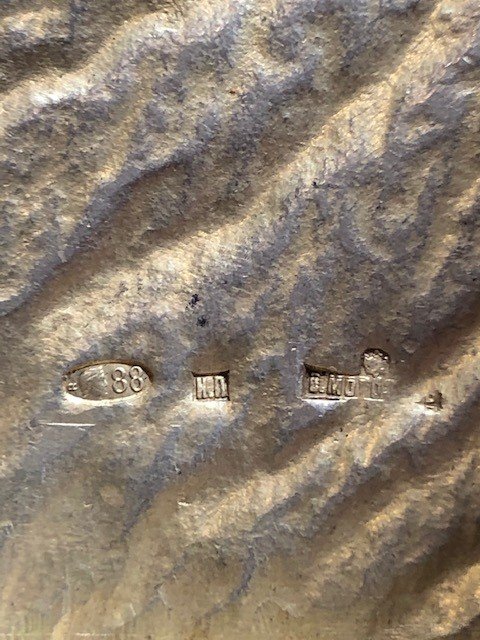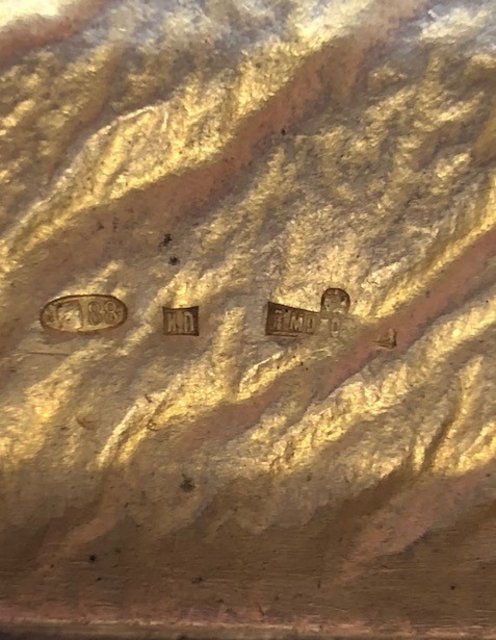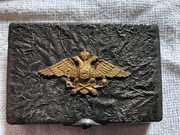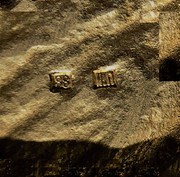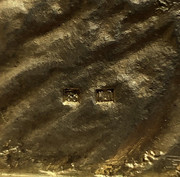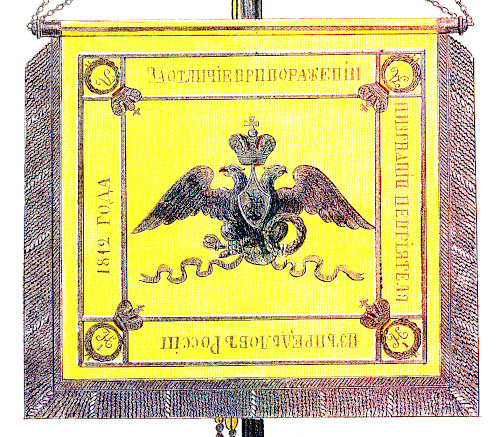Russian cigarette case
Russian cigarette case
Hello,
I would like to ask for your help in identifying the maker of a Russian cigarette case.
I have some pictures of the hallmarks but I do not know how to attach the pictures.
Can you please help?
Thank you very much
Filippos
I would like to ask for your help in identifying the maker of a Russian cigarette case.
I have some pictures of the hallmarks but I do not know how to attach the pictures.
Can you please help?
Thank you very much
Filippos
Re: Russian cigarette case
Hi, welcome to the forum. For information how to attach and embedded images see:
viewtopic.php?f=5&t=42199
Peter
viewtopic.php?f=5&t=42199
Peter
Re: Russian cigarette case
Thank you Peter for your help!
Re: Russian cigarette case
Hi Filippos,
Welcome to the Forum.
Can you post an image of the whole piece?
Trev.
Welcome to the Forum.
Can you post an image of the whole piece?
Trev.
Re: Russian cigarette case
Yes, I would also like to see the whole object. Could you kindly also show sharper and bigger close-ups of the marks but crop the photo to the marks only. I see a problem here as for now. Is the Maker's mark ИП or НП ? You see on my list of V. Morozow's masters and subcontractors I cannot find those initials. Who would the maker be? Well actually I have one, but the problem is that he was active 1867-1874 and the kokoshnik was implemented not earlier than 1908. In addition, the court supplier mark is usually left or right of the factory's name and here it is above ???
Re: Russian cigarette case
Why would that [88] be hallmarked there, just the number 88 in a square cartouche? I can't recall ever seeing that before. Wouldn't it be very difficult to create a forgery of a samorodok method object?
Re: Russian cigarette case
What does the inside of the case look like? :::: Are there old straps that were used to secure the cigarettes? :::::
Re: Russian cigarette case
The inside of the case does not have straps.
The case does not open in two equal parts as the lid that opens does not run the length of the top.
Therefore the cigarettes are kept in place by the fixed parts of the case on each side of the lid.
I am afraid I do not have a picture of the case open.
The interior is gold washed as shown from the pictures of the hallmarks.
The case does not open in two equal parts as the lid that opens does not run the length of the top.
Therefore the cigarettes are kept in place by the fixed parts of the case on each side of the lid.
I am afraid I do not have a picture of the case open.
The interior is gold washed as shown from the pictures of the hallmarks.
Re: Russian cigarette case
Hi,
In regard of maker`s initials (subcontactor) I cannot identify:
The Morozov trading house attracted good craftsmen as subcontractors, who found it difficult to get raw materials and independently sell their products. So, for example, for Morozov's firm worked: gold and silversmith Peter Airaksinen from St. Petersburg, who in 1876 had a workshop in Helsingfors; silversmith Johann (Ivan) Konstantinovich Allenius - a native of Finland, owner of a silverware workshop in St. Petersburg, in 1898 he was elected a deputy to conduct a control and audit inspection of commercial and industrial establishments; gold-silversmith Andrey Ferdinandovich Seppänen - a native of Finland, since 1873 the owner of a silver workshop; goldsmith Tiander Frederick - a native of Finland, studied with his father Frederick Tiander, in 1898 he had his own workshop in St. Petersburg and had apprentices. There are also known relationships between Morozov and Semyon Grigorievich Galkin, the owner of the silver workshop, who in 1892 founded the trading house "S.G. Galkin and Co.
In regard of maker`s initials (subcontactor) I cannot identify:
The Morozov trading house attracted good craftsmen as subcontractors, who found it difficult to get raw materials and independently sell their products. So, for example, for Morozov's firm worked: gold and silversmith Peter Airaksinen from St. Petersburg, who in 1876 had a workshop in Helsingfors; silversmith Johann (Ivan) Konstantinovich Allenius - a native of Finland, owner of a silverware workshop in St. Petersburg, in 1898 he was elected a deputy to conduct a control and audit inspection of commercial and industrial establishments; gold-silversmith Andrey Ferdinandovich Seppänen - a native of Finland, since 1873 the owner of a silver workshop; goldsmith Tiander Frederick - a native of Finland, studied with his father Frederick Tiander, in 1898 he had his own workshop in St. Petersburg and had apprentices. There are also known relationships between Morozov and Semyon Grigorievich Galkin, the owner of the silver workshop, who in 1892 founded the trading house "S.G. Galkin and Co.
Торговый дом Морозова привлекал для работы хороших мастеров, которым было трудно доставать сырье и самостоятельно реализовывать свою продукцию. Так, например, на фирму Морозова работали: золото-серебряных дел мастер Айраксинен Петер из Санкт-Петербурга, в 1876 году открывший мастерскую в Гельсингфорсе; серебряных дел мастер Аллениус Иоганн (Иван) Константинович – уроженец Финляндии, владелец мастерской серебряных изделий в Петербурге, в 1898 году выбран депутатом, проводящим контрольно-ревизионный обход торгово-промышленных заведений; золото-серебряных дел мастер Сеппянен Андрей Фердинандович – уроженец Финляндии, с 1873 года владелец «серебряной» мастерской; золотых дел мастер Тиандер Фредерик - уроженец Финляндии, учился у отца Фредерика Тиандера, в 1898 году имел свою мастерскую в Петербурге и учеников. Известны также взаимосвязи Морозова с Семеном Григорьевичем Галкиным, владельцем «серебряной» мастерской, в 1892 году основавшим торговый дом «С.Г. Галкин и Ко».
Re: Russian cigarette case
Due to lower melting point 88 silver is more easily workable.
Samorodok is a Russian word meaning that the metal is in its pure or natural state.
The samorodok (reticulation) technique produces a textured nugget like effect simulating a molten surface.
This result is obtained by heating gold or silver to a temperature near the melting point and cooling it abruptly in water.
Samorodok is a Russian word meaning that the metal is in its pure or natural state.
The samorodok (reticulation) technique produces a textured nugget like effect simulating a molten surface.
This result is obtained by heating gold or silver to a temperature near the melting point and cooling it abruptly in water.
Re: Russian cigarette case
Let's clarify this "Morozov case" a bit more. The name Morozov is not an uncommon name in Russia. Actually there were several Morozows. The two most important was Ivan Ekimovich Morozov 1825-1885 and the other was
Ivan Ivanovich Morozov 1849-1898. They were not related, but both court suppliers.
With Ivan Ekimovich worked the following masters. Note the spelling! and with whom Petter Airaksinen worked:
Vasilij Kangin
Fredrik Tiander (Fredriks father worked 1823-1869 in Lovisa/FI, not in St. Petersburg/RU)
Adam Herttuainen
Johan Allenius
Vladimir Morozov
Johan Passonen
Anders Seppänen
Mihail Bogdanov
Erik Kollin
Heikki Kaksonen
In addition, the to name unknown A.L., НБ and ИА. If somebody knows their names or more names, I would be grateful to know them, thank you.
Semyon Galkin as subcontractor to Morozov is new to me. Are you sure AG2012? I'm not, Galkin was located in Moscow. Had he a branch in St. Petersburg?
With Ivan Ivanovich worked
Ivan Arahanov
Ivan Morozov
and
Petter Airaksinen
It is important not to mix those two Morozovs and who worked with whom!
Ivan Ivanovich Morozov 1849-1898. They were not related, but both court suppliers.
With Ivan Ekimovich worked the following masters. Note the spelling! and with whom Petter Airaksinen worked:
Vasilij Kangin
Fredrik Tiander (Fredriks father worked 1823-1869 in Lovisa/FI, not in St. Petersburg/RU)
Adam Herttuainen
Johan Allenius
Vladimir Morozov
Johan Passonen
Anders Seppänen
Mihail Bogdanov
Erik Kollin
Heikki Kaksonen
In addition, the to name unknown A.L., НБ and ИА. If somebody knows their names or more names, I would be grateful to know them, thank you.
Semyon Galkin as subcontractor to Morozov is new to me. Are you sure AG2012? I'm not, Galkin was located in Moscow. Had he a branch in St. Petersburg?
With Ivan Ivanovich worked
Ivan Arahanov
Ivan Morozov
and
Petter Airaksinen
It is important not to mix those two Morozovs and who worked with whom!
Re: Russian cigarette case
The link in Russian, but useful, with several marks, too. Looks well informed to me:
https://lermontovgallery.ru/spravochnik ... e-morozov/
Have a nice Sunday.
https://lermontovgallery.ru/spravochnik ... e-morozov/
Have a nice Sunday.
Re: Russian cigarette case
AG2012
Maybe they are "well" informed regarding general questions, but the information regarding the makers is insufficient and partly incorrect. The names are spelled incorrectly and the writer has mixed the two Morozows. Airaksinen didn't work for I.E. Morozov but for I. I. Morozov a completely different company with no connection to I. E. Morozov, but located on Nevsky Prospekt, Milyony row, while I. E: Morozov was located in Gostny Dvor Perinnaja linie 36. Close but not close enough.
If requested I can show the working periods for almost every master of both Morozovs. The photos are BTW copied directly from Ivanov. The writer should have read the text too and not just copied without thinking. It is disinformation like this that causes problems later as you can already see. Just take my word for it, use my info and skip the rest.
In addition, I'm very doubtful about the claimed cooperation with the Galkin company. Galking didn't have a branch in St. Petersburg and I haven't found or seen any connection between Morozov and Galkin. Until further more reliable sources are presented I will not accept it.
Maybe they are "well" informed regarding general questions, but the information regarding the makers is insufficient and partly incorrect. The names are spelled incorrectly and the writer has mixed the two Morozows. Airaksinen didn't work for I.E. Morozov but for I. I. Morozov a completely different company with no connection to I. E. Morozov, but located on Nevsky Prospekt, Milyony row, while I. E: Morozov was located in Gostny Dvor Perinnaja linie 36. Close but not close enough.
If requested I can show the working periods for almost every master of both Morozovs. The photos are BTW copied directly from Ivanov. The writer should have read the text too and not just copied without thinking. It is disinformation like this that causes problems later as you can already see. Just take my word for it, use my info and skip the rest.
In addition, I'm very doubtful about the claimed cooperation with the Galkin company. Galking didn't have a branch in St. Petersburg and I haven't found or seen any connection between Morozov and Galkin. Until further more reliable sources are presented I will not accept it.
Re: Russian cigarette case
You may be right; many ``facts`` are simply copied from elsewhere and when repeated often enough, become the truth.
Here is another source; Galkin seem to have supplied sacral objects, but I have not seen both marks (i.e. Galkin + Morozov) together.
Semyon Grigorievich Galkin was the owner of a silverware workshop. In 1892 he founded the "Trading House S.G. Galkina and Co. " The factory took part in the All-Russian Art and Industrial Exhibition in 1896 in Nizhny Novgorod, where it received a medal. Among Galkin's customers were such well-known enterprises as the firm of O.F. Kurlyukov. To the Firm I.E. Morozov in St. Petersburg, Galkin supplied engraved and chased covers, crosses and paintings. Among the masters who collaborated with the Galkins was the famous jeweler Kuzma Ivanovich Konov, who made crosses and icon lamps, as well as one of the best Moscow firms of Gustav Gustavovich Klingert, the famous master P.G. Loskutov. The 30th artel of the silversmiths and the 29th Trudovaya Artel collaborated with the Galkins.
Here is another source; Galkin seem to have supplied sacral objects, but I have not seen both marks (i.e. Galkin + Morozov) together.
Semyon Grigorievich Galkin was the owner of a silverware workshop. In 1892 he founded the "Trading House S.G. Galkina and Co. " The factory took part in the All-Russian Art and Industrial Exhibition in 1896 in Nizhny Novgorod, where it received a medal. Among Galkin's customers were such well-known enterprises as the firm of O.F. Kurlyukov. To the Firm I.E. Morozov in St. Petersburg, Galkin supplied engraved and chased covers, crosses and paintings. Among the masters who collaborated with the Galkins was the famous jeweler Kuzma Ivanovich Konov, who made crosses and icon lamps, as well as one of the best Moscow firms of Gustav Gustavovich Klingert, the famous master P.G. Loskutov. The 30th artel of the silversmiths and the 29th Trudovaya Artel collaborated with the Galkins.
(admin edit - please, no linking to commercial websites, see Posting Requirements )Семен Григорьевич Галкин – владелец мастерской серебряных изделий. В 1892 году основал «Торговый дом С.Г. Галкина и Ко». Фабрика участвовала на Всероссийской художественно-промышленной выставке 1896 года в Нижнем Новгороде, где получила медаль. Среди заказчиков Галкина были такие известные предприятия, как фирма О.Ф. Курлюкова. Фирме И.Е. Морозова в Санкт-Петербурге Галкин поставлял гравированные и чеканные покровы, кресты и живопись. Среди мастеров, сотрудничавших с Галкиными, был знаменитый ювелир Кузьма Иванович Конов, выполнявший кресты и лампады, а также одна из лучших московских фирм Густава Густавовича Клингерта, известный мастер П.Г. Лоскутов. С Галкиными сотрудничала 30-я артель серебряников, а также 29-я Трудовая Артель.
Re: Russian cigarette case
Could be or not, but as you said, "facts etc." are often copied form one "source" to another without checking the reliability of the source. The text is more or less the same as in the previous text regarding sacred objects etc. BUT! Didn't you noticed that in the text is mentioned the 30th artel? There is no evidence shoved that this 30th artel would have ever existed. What this indicates is that the text is to some extent copied from an unknown source and/or the writer doesn't know what he is writing about....!
Kurlykov is known and famous, so are Morozov, Konov and Klingert. Pyotr Loskutov worked with Sazikov not with Galkin? So who is Galkin? Postnikova doesn't recognize him at all. In Ivanov only a short notice; "mentioned 1898", about his company "mentioned 1912"......." that's all. Sorry AG2012, not very convincing text. But, maybe Galkin was "famous" too. Unfortunately I don't know anything about him, do you?
Kurlykov is known and famous, so are Morozov, Konov and Klingert. Pyotr Loskutov worked with Sazikov not with Galkin? So who is Galkin? Postnikova doesn't recognize him at all. In Ivanov only a short notice; "mentioned 1898", about his company "mentioned 1912"......." that's all. Sorry AG2012, not very convincing text. But, maybe Galkin was "famous" too. Unfortunately I don't know anything about him, do you?
Re: Russian cigarette case
What`s the application ? Imperial eagle with torches; a military regiment, a service corps ? Or civilian government service.
If the case was kept in a family for hundred years, the owner is supposed to know where the ancestor served and who he was.
If the case was kept in a family for hundred years, the owner is supposed to know where the ancestor served and who he was.
Re: Russian cigarette case
Dear all,
Thank you for your answers.
(Responding to AG2012) If the question about the "Imperial eagle with torches" is addressed to me, then the information I have is that the original owner of the cigarette case was indeed in the Russian military. However I do not have further information regarding which branch or regiment he served.
As already indicated the item has been in the family probably since the early 1900s. Precise information on the name of the owner is not available.
Thank you for your answers.
(Responding to AG2012) If the question about the "Imperial eagle with torches" is addressed to me, then the information I have is that the original owner of the cigarette case was indeed in the Russian military. However I do not have further information regarding which branch or regiment he served.
As already indicated the item has been in the family probably since the early 1900s. Precise information on the name of the owner is not available.

